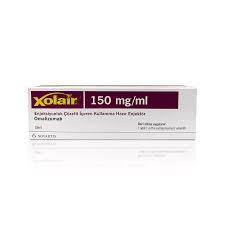Xolair

Indications and Applications
Designed for individuals aged 6 and above whose asthma remains inadequately managed with inhaled mineralocorticoids .
Indicated for those with elevated IgE levels and confirmed allergies to perennial allergens.
Aids in diminishing asthma flare-ups and reliance on corticosteroids.

Chronic Idiopathic Urticaria (CIU):
Intended for patients aged 12 and older suffering from persistent hives despite H1 antihistamine treatment.
alleviates itching and reduces the frequency of hives.
Nasal Polyps:
Recommended for adults with nasal polyps that are unresponsive to nasal corticosteroids.
Facilitates a reduction in the size of nasal polyps and enhances symptoms such as nasal congestion.
Mechanism of Action
Xolair is a humanized monoclonal antibody derived from recombinant DNA technology, specifically targeting the C3 domain of the Fc region of IgE. This interaction inhibits IgE from binding to high-affinity IgE receptors (FcRI) located on mast cells and basophils, thereby curtailing the release of inflammatory substances.
Dosage and Administration
Administration:
Delivered via subcutaneous injection.
Recommended sites include the upper arm, thigh, or abdomen, with a suggestion to rotate injection locations to reduce irritation.
Dosing for Asthma:
Determined by baseline IgE levels (IU/mL) and body weight (kg).
Administered every 2 to 4 weeks, with adjustments made according to clinical response.
Dosing for CIU:
Typically involves 150 mg or 300 mg every 4 weeks.
Adjustments are made based on the patient’s response and symptom severity.
Dosing for Nasal Polyps:
Weight-based dosing is administered every 2 to 4 weeks.
Pharmacokinetics
Absorption: Peak serum concentration is achieved approximately 7-8 days post-subcutaneous administration.
Distribution: The volume of distribution (Vd) is approximately 78 ± 32 mL/kg.
Metabolism: Primarily metabolized into peptides and amino acids through catabolic processes.
Elimination: The half-life is around 26 days, facilitating dosing every 2 to 4 weeks.
Efficacy Studies
Asthma: Clinical investigations have revealed that Xolair markedly diminishes the frequency of asthma attacks and the reliance on corticosteroids, while enhancing overall quality of life.
CIU: Clinical trials have illustrated a notable decrease in itch intensity and hive prevalence, offering solace where traditional antihistamines have proven ineffective.
Nasal Polyps: Participants in trials reported a reduction in polyp size and alleviated nasal congestion.
Side Effects
Common Side Effects:
– Reactions at the injection site (discomfort, swelling, redness, itching)
– Upper respiratory infections
– Sinusitis
– Headaches
– Fatigue
Serious Side Effects:
– Anaphylaxis: Although rare, this condition can be life-threatening; patients must be closely monitored during and after administration.
– Elevated risk of cardiovascular and cerebrovascular incidents: Certain studies suggest a possible correlation, necessitating vigilant monitoring.
– Potential for malignancies: There exists a marginally increased risk, which remains under scrutiny.
– Churg-Strauss syndrome: A rare yet serious condition characterized by vasculitis and eosinophilia.
Precautions and Warnings
Anaphylaxis: It is imperative that patients are observed for a minimum of two hours following the initial injections and for at least thirty minutes after subsequent doses.
Infections: Individuals with severe asthma face a heightened risk of helminth infections.
Cardiovascular risks: Those with a history of heart conditions should be monitored with particular care.
Pregnancy: Classified as Pregnancy Category B, there is insufficient data regarding the use of Xolair in pregnant women, thus it should only be administered when absolutely necessary.
Drug Interactions
No significant drug interactions have been identified; however, it is crucial to inform healthcare providers of all medications and supplements being taken.
Cost and Assistance Programs
Cost: Xolair is a premium medication, with pricing varying based on dosage, treatment duration, and healthcare provider.
Insurance Coverage: Most insurance plans include Xolair as part of their specialty medication offerings, though prior authorization is frequently required.
Patient Assistance Programs: Offered by the esteemed manufacturers, Genentech and Novartis, these programs are designed to support eligible patients in managing their out-of-pocket expenses.
Patient Counseling Information
Self-Administration: Patients may receive comprehensive training on the self-administration of injections, should it be deemed suitable.
Monitoring: It is imperative that patients are well-informed about the signs of anaphylaxis and are instructed to seek immediate medical assistance if such symptoms arise.
Compliance: Strict adherence to the prescribed regimen is essential for optimal effectiveness.
Lifestyle Adjustments: Patients are encouraged to maintain their current asthma or allergy medications unless otherwise directed by their healthcare provider.
Summary
Xolair (omalizumab) represents a sophisticated therapeutic option for individuals grappling with challenging allergic conditions, including asthma, chronic idiopathic urticaria (CIU), and nasal polyps. While it provides remarkable advantages, it necessitates vigilant monitoring due to the risk of serious side effects, particularly anaphylaxis. Its administration should be meticulously overseen through comprehensive patient assessments and consistent follow-up appointments.

Leave a Reply